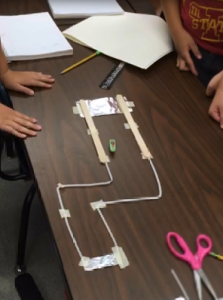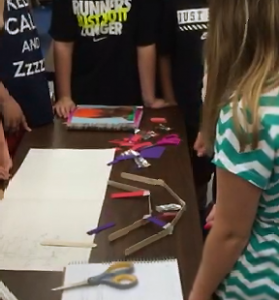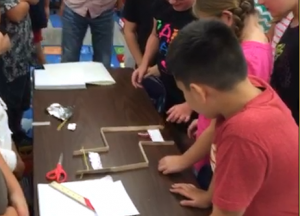With the school year well underway, the Trinect triads have begun moving and shaking- quite literally. This fall semester each group will teach a lesson using small robotic creatures called Hexbug® Nanos.
Shaped like an insect and roughly the size of a peanut, Hexbugs are powered by a small m otor causing up and down movements of the legs so rapid, the creature appears to be vibrating across surfaces. While many children across America use these small toys for play, they have be providing a learning challenge for our elementary students and a growth experience for our triads.
otor causing up and down movements of the legs so rapid, the creature appears to be vibrating across surfaces. While many children across America use these small toys for play, they have be providing a learning challenge for our elementary students and a growth experience for our triads.
Hexbugs use the latest technologies in their programming to avoid obstacles and create a new path. Students have be utilizing this technology as well as scientific inquiry and the engineering process to test and challenge their Hexbugs.
After testing seven different sample materials and observing what the Hexbug avoids, students were in charge of creating a maze for the Hexbug to traverse. Each group was only allowed to use five full sized materials of the seven they tested including construction paper, aluminum foil, and pipe cleaners (among other common items in an elementary classroom). Their mazes were required to be 12 inches long and include at least two turns for the robots to complete.
While students a re using this activity to study and apply scientific inquiry and the engineering design process, the triads had a slightly different goal when they completed the same activity during the summer workshop. The maze activity provided group engagement for the three members, however many learning opportunities were purposefully omitted by workshop facilitators. This enabled the groups to work collaboratively by utilizing the expertise of each team member to enhance the hexbug activity for implementation in the classroom.
re using this activity to study and apply scientific inquiry and the engineering design process, the triads had a slightly different goal when they completed the same activity during the summer workshop. The maze activity provided group engagement for the three members, however many learning opportunities were purposefully omitted by workshop facilitators. This enabled the groups to work collaboratively by utilizing the expertise of each team member to enhance the hexbug activity for implementation in the classroom.
This enhancement was designed to reflect deeper content learning, stronge r alignment to the engineering design process and incorporate methods of co-teaching. For the students, growth in the short term was measured as a reflection of interest and enjoyment in engineering. During researcher’s observations of the Hexbug lessons, students were heard exclaiming “Can we do engineering every day?” and “This is FUN!”
r alignment to the engineering design process and incorporate methods of co-teaching. For the students, growth in the short term was measured as a reflection of interest and enjoyment in engineering. During researcher’s observations of the Hexbug lessons, students were heard exclaiming “Can we do engineering every day?” and “This is FUN!”
While engineering activities can motivate and engage students, the next challenge for our triads will involve simultaneously supporting and extending student’s content learning.